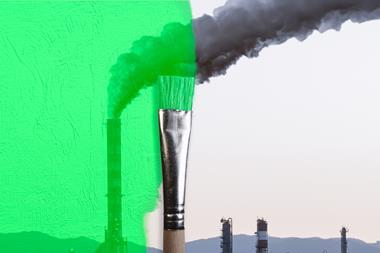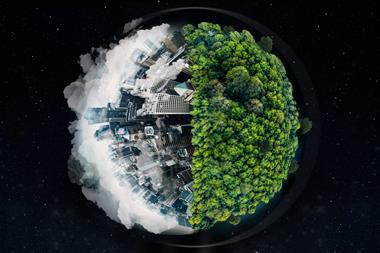L’Oréal Groupe, a company known for its attention to sustainability and resilience, isn’t resting on its laurels when it comes to assessing climate-related risks and building an adaptation strategy to address them.
This article is part of our special report on Climate Change. You can download the full report, which includes analysis, case studies, features, and the results from our research here.
Widely recognised for its attention to environmental matters – L’Oréal Groupe’s environmental practices were ranked among the top 1% of companies by CDP Global for 8 years in a row – the company isn’t slowing efforts to strengthen resilience.
On the contrary, a collaboration with Zurich Resilience Solutions is helping the beauty products giant develop climate adaptation measures. that will further bolster its ability to protect physical assets from climate-related harm.

“Climate change is no longer a hypothesis,” says Christine Gendrot, insurance director at L’Oréal Groupe. “That’s why we’ve undertaken this risk and insurance strategy to further our work to ensure our long-term insurability and mitigate the risk to our operations and the communities where we are located.”
L’Oréal Groupe has shown that it doesn’t shy away from environmental challenges, with goals that have been nothing if not ambitious.
The company has set a primary climate change objective for 2030. Their goal is to align their greenhouse gas emissions with the +1.5°C scenario. This means they aim to reduce greenhouse gas emissions by 50% per finished product across their entire value chain (scopes 1, 2 and 3) compared to levels in 2016.
“Wwe’ve undertaken this risk and insurance strategy to further our work to ensure our long-term insurability and mitigate the risk to our operations and the communities where we are located”
Further, all of the water used in industrial processes will be recycled and reused in a loop. Also by 2030, 100% of the biobased ingredients for formulas or packing ingredients will be traceable and will come from sustainable sources; none will be linked to deforestation. Plans call for half of plastic packaging to come from recycled or biobased sources by 2025, with all of it from those sources five years later.
“L’Oréal Groupe’s work with Zurich Resilience Solutions fits within our broader sustainability ambitions that include these goals,” Christine Gendrot says.
TIME TO ACT

There is some urgency for companies such as L’Oréal Groupe to address the potential effects of a warming climate. The planet’s temperature rose to record heights in 2023 after a steady climb the preceding four years.
The World Economic Forum claims that each increase in temperature of 1°C leads to a loss of 12% in world gross domestic product. Insured losses could double within 10 years as temperatures rise and extreme weather events become more frequent and intense, according to the Swiss Re Institute (1).
Global financial losses due to climate events reached a record $280 billion in 2023, of which only 40% was insured, the reinsurer found. Addressing the challenge involves multiple stakeholders, according to Gendrot. “Collaboration between the risk manager, insurance manager and other parts of the organisation is vital in developing a successful adaptation plan to protect our operations against this threat.”
Companies could find there is a cost to delaying adaptation planning, according to Yassine Saidoun, head of Zurich Resilience Solutions France. “Left unaddressed, climate-related physical risks could not only lead to reduced resilience, but also to significant financial losses. Acting now will be less expensive and more cost-effective than procrastinating,” he adds.
ADAPTATION PLANNING REQUIRES VISION
While mitigation focuses on preventing greenhouse gas emissions and lowering the risk of climate-related losses, adaptation is about adjusting to the physical effects of climate change.
Most large organisations are well-into their work to mitigate climate-related losses, but only 21% have begun to address adaptation plans, according to an S&P Global Ratings’ report (2).
That could be because it is not a simple task for a large company. In L’Oréal Groupe’s case, the 115-year-old company boasts a global sales network of stores, salons and other outlets, along with 20 research centres in 11 countries.
“We knew they could provide a high level of data-driven service in a comfortable, collaborative approach.”
L’Oréal Groupe is a “forward-thinking company” that realised the value of a collaboration with Zurich Resilience Solutions to build an adaptation plan that would fit the company’s overall sustainability strategy to protect its far-flung global assets, Gendrot says.
“Zurich Insurance has long been a L’Oréal Groupe partner,” she adds “And considering their expertise in climate adaptation work, we knew they could provide a high level of data-driven service in a comfortable, collaborative approach.”
“It’s a natural partnership,” Saidoun agrees. “Both companies are well-advanced in climate mitigation and adaptation awareness.”
QUANTIFYING THE RISKS
Zurich Resilience Solutions and L’Oréal Groupe began their adaptation work by mapping climate risks at the portfolio level.
In 2023, Zurich Resilience Solutions performed a global exposure analysis for L’Oréal Groupe that was based on various scenarios developed by the Intergovernmental Panel on Climate Change and time horizons to 2030 and 2050.
That work led to the identification of the company’s material climate exposures. It was work that served a dual purpose, creating for L’Oréal Groupe’s insurance and risk management department the double materiality assessment called for in the European Union’s Corporate Sustainability Reporting Directive.
“[The work] challenged our view on our own risks and created a benchmark of actions we needed to take as we prepare for coming climate changes”
The assessment shows how the company’s operations affect the environment, and, conversely, how the environment impacts L’Oréal Groupe. In addition, the work can help meet requirements in the Task Force on Climate-related Financial Disclosures.
Zurich Resilience Solutions’ risk quantification approach relied partly on findings gathered at onsite visits, rather than depending solely on high-level overviews produced by modelling. “Adaptation strategies need to be planned at a local level, taking into account every aspect of the site’s value chain,” emphasises Saidoun.
Climate risk specialists identified at site level with L’Oréal Groupe industrial site teams local vulnerabilities to climate exposures and the potential monetary losses that could result from a changing climate. The potential impact of chronic risks such as increasing temperatures and water availability was also assessed, and all of the information was used to help shape the adaptation plan.
The work “challenged our view on our own risks and created a benchmark of actions we needed to take as we prepare for coming climate changes,” Gendrot says.
A CUSTOMISED APPROACH TO ADAPTATION
“Not all organisations will be impacted the same way by acute or chronic risk exposures,” says Amar Rahman, global head of climate & sustainability solutions at Zurich Resilience Solutions. “That’s why this work is a key part of understanding how to tailor an adaptation plan that fits within the company’s overall sustainability strategy.”
The amount of work that goes into developing an adaptation plan can seem overwhelming when considering the number of data providers, modellers and other third-party sources that are available to help with the effort, according to Saidoun. Because insurers have all of the resources needed as well as “skin in the game” when it comes to preventing losses, they are an obvious choice when it comes to adaptation planning, Saidoun says.
“Not all organisations will be impacted the same way by acute or chronic risk exposures”
“Zurich has developed its own set of climate data and models for the insurance business,” Saidoun says. “We use these resources to help our customers assess physical climate-related risks and put together an adaptation roadmap. Zurich Resilience Solutions has more than 950 risk experts based around the world who help businesses and communities develop their climate resilience strategies.”
Gendrot agrees that there are good reasons to work on adaptation planning with an insurer. “The amount of resources and expertise that insurers such as Zurich can provide makes the difficult work of bringing together multiple stakeholders within the organisation easier. Our collaboration with Zurich Resilience Solutions to develop our adaptation strategy proves the worth of involving an insurer early in the process.
This article is part of our special report on Climate Change. You can download the full report, which includes analysis, case studies, features, and the results from our research here.
(1) ‘New record of 142 natural catastrophes accumulates to USD 108 billion insured losses in 2023, finds Swiss Re Institute’, Swiss Re Group
(2) ‘Risky Business: Companies’ Progress On Adapting To Climate Change’, Sustainability Insights, S&P Global














No comments yet